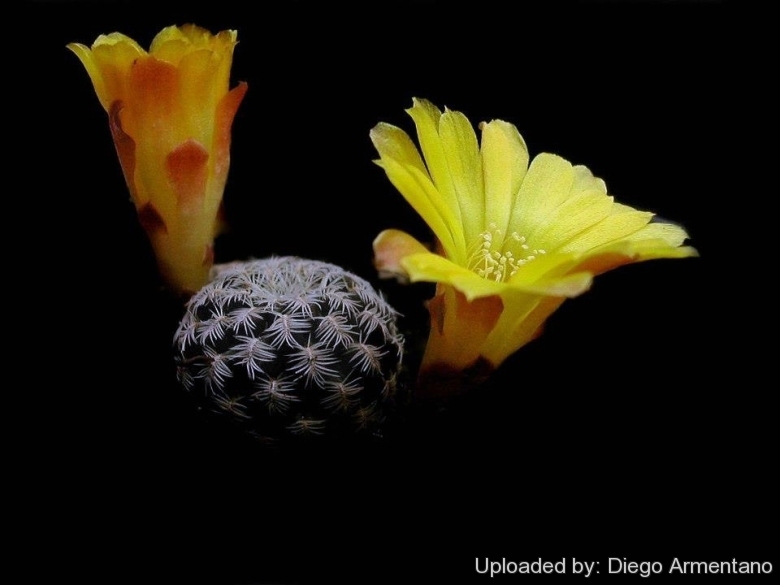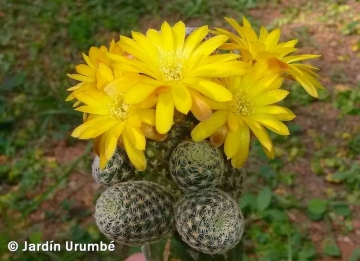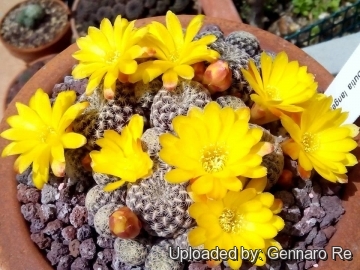Accepted Scientific Name: Rebutia cardenasiana (R.Vásquez) G.Navarro
Lazaroa 17: 76 1996

Sulcorebutia langeri Photo by: Diego Armentano
Origin and Habitat: North of Vallegrande, Santa Cruz, Bolivia
Altitude range: 1900-2100 metres above sea level.
Type Locality: Department of Santa Cruz, province of Valle Grande, a few kilometers north of the settlement of Vallegrande, 2050-2100m, Bolivia.
Habitat: Andean Chaco. Thermotropical semiarid. Sulcorebutia langeriSN|31364]]SN|31364]] grovs on a sandstone hill of white appearance from distance in a dry forest area of Neocardenasia herzogiana and Schinopsis haenkeana. The secies is strictly endemic and insufficiently known in habitat.
Synonyms:
See all synonyms of Rebutia cardenasiana
back
Accepted name in llifle Database:Rebutia cardenasiana (R.Vásquez) G.NavarroLazaroa 17: 76 1996Synonymy: 6
back
Description: Sulcorebutia langeriSN|31364]]SN|31364]] is a form of Rebutia cardenasiana, but not sufficiently differentiated and considered merely a local variant of the latter (if not the same). It has pectinate white spines covering the black-green stems and produces sunny yellow flowers (in profusion in spring) larger than the tiny bodies. S. langeri is one of the easier to recognize yellow-flowering Sulco, well-known bot not yet very common species in cultivation.
Derivation of specific name: It was discovered near Vallegrande by Bro. Andrew Langer of Pampa Grande.
Stem: Solitary or clustering,
Ribs: ca. 14.
Spines: 21-25, up to 3 mm long mostly white, occasionally white and brown. The spines are adpressed, pectinate and finely hairy if seen through a lens.
Flowers: Yellow and orange.
Fruits: Brown with pink scales.
Subspecies, varieties, forms and cultivars of plants belonging to the Rebutia cardenasiana group
 Rebutia cardenasiana (R.Vásquez) G.Navarro: has tiny globular stems with short pectinate white, yellowish or brownish spines. Flowers are yellow. Distribution: Cochabamba, Bolivia.
Rebutia cardenasiana (R.Vásquez) G.Navarro: has tiny globular stems with short pectinate white, yellowish or brownish spines. Flowers are yellow. Distribution: Cochabamba, Bolivia. Sulcorebutia langeri K.Augustin & Hentzschel: has pectinate white spines covering the black-green stems and produces sunny yellow flowers. North of Vallegrande, Santa Cruz, Bolivia.
Sulcorebutia langeri K.Augustin & Hentzschel: has pectinate white spines covering the black-green stems and produces sunny yellow flowers. North of Vallegrande, Santa Cruz, Bolivia. Sulcorebutia langeri G245/5 km 10, Valle Grande to Mataral, Santa Cruz, Bolivia: has pure white spines and nice white flowers instead of yellow. Distribution: km 10, Valle Grande to Mataral, Santa Cruz, Bolivia
Sulcorebutia langeri G245/5 km 10, Valle Grande to Mataral, Santa Cruz, Bolivia: has pure white spines and nice white flowers instead of yellow. Distribution: km 10, Valle Grande to Mataral, Santa Cruz, Bolivia
Bibliography: Major references and further lectures
1) Michael Nee “Flora de la Región del Parque Nacional Amboró Bolivia: Magnoliidae, Hamamelidae y Caryophyllidae” Editorial FAN, 2004
2) Lazaroa, Volumi 16-18 Departamento de Botánica, Facultad de Farmacia, Universidad Complutense., 1995
 Sulcorebutia langeri Photo by: Alexander Arzberger
Sulcorebutia langeri Photo by: Alexander Arzberger Sulcorebutia langeri Photo by: Gennaro Re
Sulcorebutia langeri Photo by: Gennaro Re Sulcorebutia langeri Photo by: Alexander Arzberger
Sulcorebutia langeri Photo by: Alexander ArzbergerSend a photo of this plant.The gallery now contains thousands of pictures, however it is possible to do even more. We are, of course, seeking photos of species not yet shown in the gallery but not only that, we are also looking for better pictures than those already present.
Read More... Cultivation and Propagation: This species loves a very permeable, coarse mineral soil as well as to be strictly kept dry throughout the winter quiescent period since it is very sensitive to any moisture excesses, To prevent rottenness it is also advisable to surround its root neck by very rough sand or grit, this help a fast water drainage and an appropriate air circulation. Plants are quite frost hardy -5 (-10)° C.
Watering Needs: Water moderately in the growing season, keep dry during the winter rest
Frost Tolerance: Overwinter in a cool place (at 0/10°C) this is important for the flowers as well as for plants health. Without this cool winter period they normally wont get any buds.
Sun Exposure: Needs a full sun exposure (light shadow my be useful in the hottest summer days)
Propagation: Seed, cutting, grafting.














